





Some rose experts recently shared their tips on growing gorgeous blossoms.
continue reading below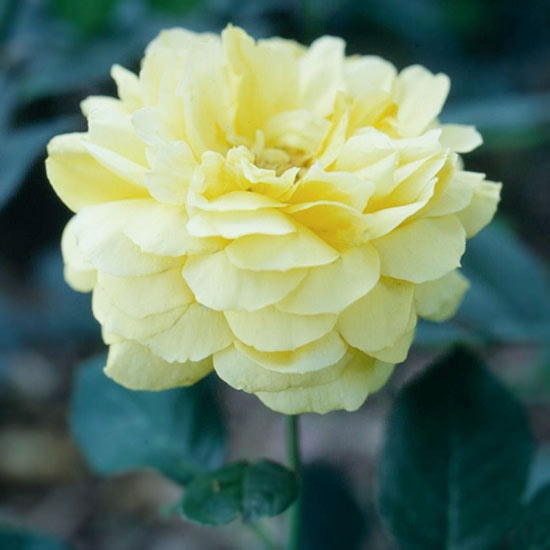
Q: What kind of site do roses require?
A: Good drainage is very important. A loose, well-drained soil is best, but roses will grow in a variety of soils. If you have a lot of heavy clay, replace it if that's practical. If not, add gypsum pellets to break down clay over time and allow water to penetrate to the roots. Also, have a soil test done. Roses prefer a pH of 6.3-6.8.
Q: How about light conditions?
A: Full sun is ideal. The plants need at least six hours of sun a day. We have some partly shaded areas that get early-morning and late-afternoon sun. Even though they're not getting six continuous hours of sun, they do okay. If you have high, bright shade, like that under a limbed-up tree, roses can do all right, but direct sun is best.
Q: Are there any cultivars that will take more shade than others?
A: 'The Fairy,' a Polyantha rose, will take quite a lot of shade. Another is 'Gruss an Aachen,' a light pink Floribunda.
Q: Any exciting new rose developments to talk about?
A: We like the Canadian roses in the Parkland and Explorer series. These come from research done by Ag Canada in Ottawa and Morden Station in Manitoba. They have marvelous hardiness for Northern gardeners, and good disease resistance. One of our favorites is 'Morden Blush,' but we have quite a few others. We also like the French 'Generosa' and 'Romantica,' and the Towne & Country series from Denmark. All of these are similar to David Austin English roses -- Old Garden roses hybridized with modern Hybrid Teas and Floribundas.
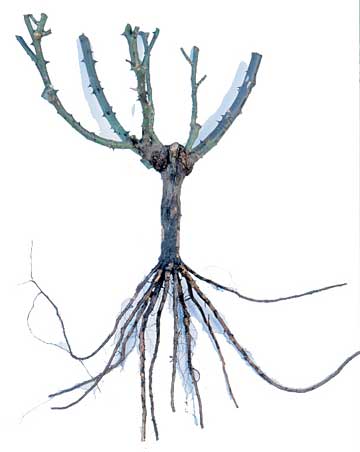 The planting depth of graftedplants depends on climate. InUSDA Zone 5 and colder, burythe swollen bud union 2 inchesbelow ground. In warmerclimates, leave it at the soilsurface or just below.
The planting depth of graftedplants depends on climate. InUSDA Zone 5 and colder, burythe swollen bud union 2 inchesbelow ground. In warmerclimates, leave it at the soilsurface or just below.
Q: Where can gardeners learn about other good cultivars?
A: The American Rose Society publishes "The Handbook for Selecting Roses." It has results and ratings from growers on hundreds of roses that are commercially available. The ARS magazine, "The American Rose," is another excellent source.
Q: When is the best time to plant roses?
A: Bareroot roses should be planted in spring, by April 15 in Zone 5. Spring planting in the South is in January and February. Planting times will vary considerably throughout the many USDA plant-hardiness Zones. Container-grown roses can be planted anytime during the growing season.
Q: You mention both bareroot and potted roses. Which one is better?
A: Some mail-order nurseries ship container plants, but most catalog orders are bareroot plants. Newer varieties are likely to be bareroot, too, as nurseries haven't had time to pot them. Many container plants come from local nurseries that buy bareroot plants and pot them up to grow larger. Either bareroot or container plants are okay, but with containers, you have to rely on the reputation of the nursery and whether they know what they are doing. The roses have to be potted correctly to grow.
Q: Are there any other factors to consider when selecting a rose?
A: In the last few years, it's become more important to know whether to plant own-root or grafted plants. Some varieties may be available only as one or the other, but where there's a choice, we like own-root. If a grafted plant gets winter-killed to below the bud union, you'll just get the rootstock variety coming back up. An own-root plant might die in winter, but it will grow back from the roots as the same cultivar. Own-root plants will be smaller than grafted ones at a given age, but they'll catch up. If you get own-root plants, ask for two-year-old ones.
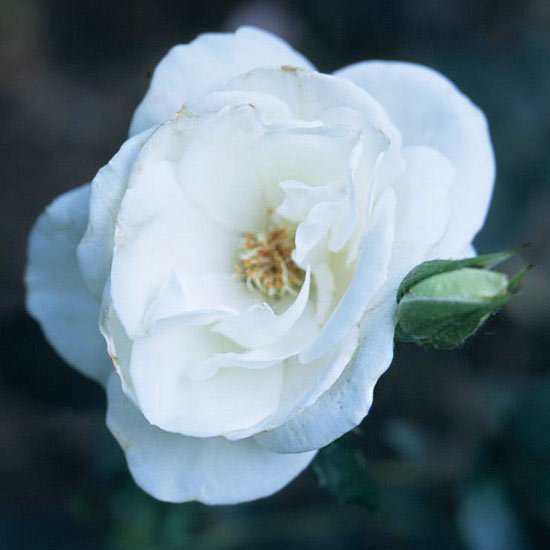
Q: How much pruning do established roses need, and when should it be done?
A: In colder regions, when the crab apples bloom in spring, prune off any dead material. Aside from that, just do maintenance pruning to take care of any crossing twigs and inward growth to keep a nice shape to the plant.
Q: What can gardeners do to encourage dormant roses to leaf out in spring?
A: We put a small plastic bag over the plant. It should be tan or light brown. Don't use very dark colors. Small grocery bags work well. Be sure to cut breathing holes near the center of the bag, and anchor it down with several stones. Keep checking under the bag until you see new growth, then remove it.
Q: Should plants be mulched?
A: We put 2-3 inches of mulch around our plants. We like wood chips -- cypress is best, but you can use anything except black walnut. Other possibilities are pine needles, cocoa hulls, sawdust, hay, straw, marsh hay, and old manure. But make sure the manure is well-rotted. Peat moss and grass cuttings should be used with caution, as they may become compacted and have a smothering effect.
Q: How much water do roses require?
A: Hybrid Teas and Floribundas need at least 2 inches of water per week; shrub roses less. Don't let the ground dry out, as this will stress the plant. Leaves and flowers start drooping and you'll probably notice some changes in leaf color.
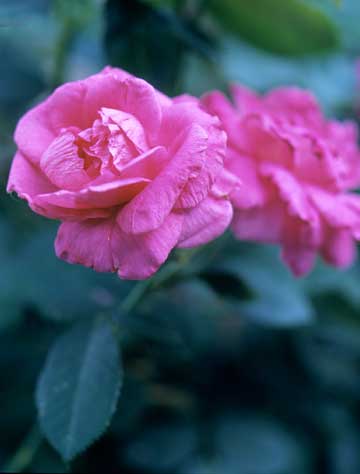 Morden Centennials seem to beresistant to black spot andpowdery mildew, two commonfungal diseases.
Morden Centennials seem to beresistant to black spot andpowdery mildew, two commonfungal diseases.
Q: What pests bother roses?
A: There can be different ones in different regions, but aphids and spider mites are pests everywhere. They are especially a problem in hot, dry weather. Keeping plants watered helps prevent infestations. Adjusting the hose nozzle to a fine spray and washing aphids and spider mites off plants will often take care of the problem without chemicals. Also, there are cane borers and leaf-cutting bees. We let these go because the damage is mainly cosmetic.
Q: Any other major pest problems?
A: Two fungal diseases that occur all over the country are black spot and powdery mildew. Some cultivars are more resistant than others. For example, we haven't noticed any on 'Morden Blush' or 'Morden Centennial,' and some of the other Canadian roses seem to be resistant.
Q: How do you deal with infestations of black spot or powdery mildew?
A: Using chemicals is a big concern among rosarians. We've cut down on the use of insecticides, using them only if we absolutely have to. For prevention or cure of black spot or powdery mildew, we follow a regular routine of spraying with fungicide every week or 10 days. Most good garden centers will carry a variety of effective products. Organic controls work better in situations where there are just a few roses. Try Safer soap or Neem or baking soda. Some rose growers have had good luck with copper-base fungicides such as Bordeaux. And you can also help prevent black spot by watering only in the morning so the foliage has a chance to dry out during the day.
Q: With all these beautiful roses, you must sometimes cut a few for the house. Any tips on cutting?
A: Some cultivars hold up better than others. Use floral preservatives in the water and cut in early morning or late afternoon, just when the bud is beginning to open. Sometimes, if we know there's hot weather or a bad storm coming, we will pick a lot of them and put them in the refrigerator to take out a few at a time.
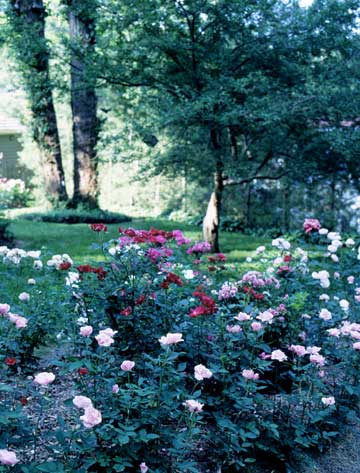 Consulting the experts willhelp you to successfully growa lush array of roses.
Consulting the experts willhelp you to successfully growa lush array of roses.
Q: What's the best way for a rose novice to get help?
A: The American Rose Society offers the Consulting Rosarians Service, a national network of trained volunteers who answer questions for free.
Q: How does a gardener find a local Consulting Rosarian?
A: Call the ARS at (800)637-6534. They can give you the name of a nearby Consulting Rosarian based on your ZIP code. There is also an ARS website at www.ars.org with lots of information. Some of the Consulting Rosarians can be contacted through the website and will answer questions via e-mail. Joining the ARS is a good idea for anyone really interested in roses. They have several helpful publications, including a rating guide for best varieties.
 Before planting, allow the rootsto soak in water overnight.
Before planting, allow the rootsto soak in water overnight.
Take a dip. Remove any broken roots from plants. Cut off the tip of every root, and cut back any extremely long roots. Dip the plants in a solution of 1 cup bleach and 5 gallons water to kill any disease organisms. A quick, one-minute dip will do.
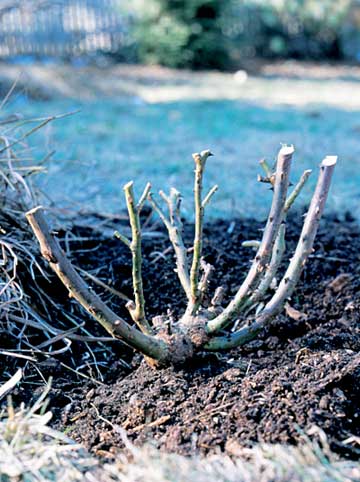 Gently tamp the soil at the base
of the plant, but don't pack the
soil down hard.
Gently tamp the soil at the base
of the plant, but don't pack the
soil down hard.
Don't pack it in. When planting bare-root roses, build up a cone-shaped mound at the bottom of the hole, then spread the roots over the mound and down into the hole on all sides. Fill the hole with amended soil, then water.
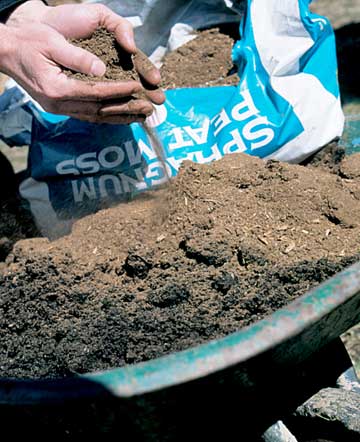 Amend the soil you removed with
peat moss.
Amend the soil you removed with
peat moss.
Amendments. Dig a hole twice as wide as the spread of the roots and about 8 inches deeper than you'll need to plant the rose at its original depth. You can throw in a handful of superphosphate and mix it around. Add gypsum pellets if you have heavy clay soil.
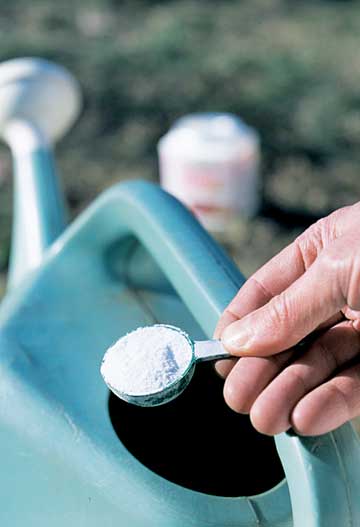 Wait to fertilize newly planted
roses until after their first
bloom.
Wait to fertilize newly planted
roses until after their first
bloom.
Food for flowers. Established roses can be fertilized just before they leaf out in spring. Slow-release fertilizers can be applied sparingly -- as little as once or twice during the growing season -- while water-soluble fertilizers may need to be applied every few weeks.
Copyright © www.100flowers.win Botanic Garden All Rights Reserved